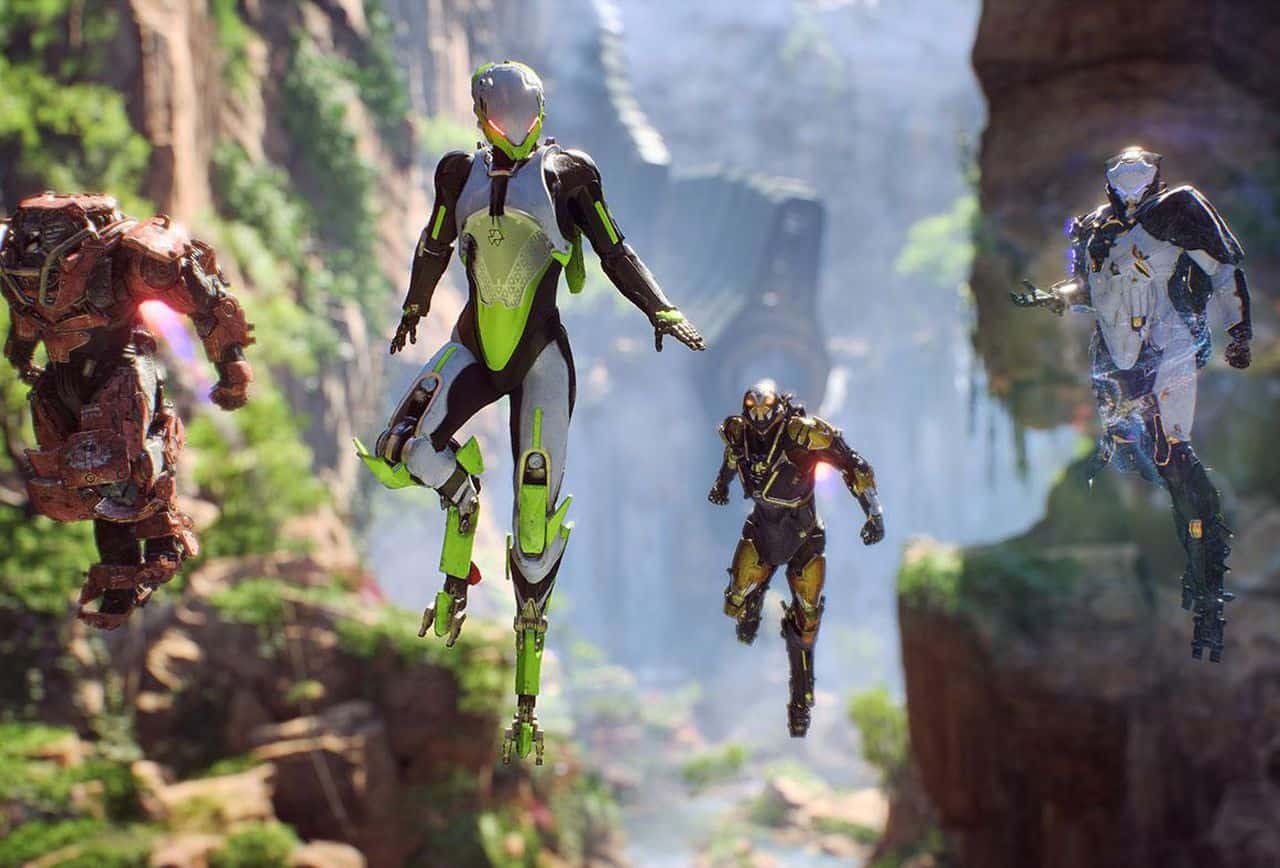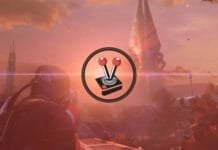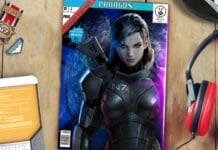At the Electronic Entertainment Exposition (E3) in 2017, Electronic Arts and Bioware revealed Anthem. A promising new massively multiplayer online (MMO) action role-playing game (RPG) looter-shooter with a science-fiction twist. The game promised to meld the best of Bioware’s storytelling abilities with EA’s expertise in the field of multiplayer. Two years later, and Anthem has released to both much fan fare and severe disappointment. Join me as I go over the brilliance and bugs of this ambitious new game.

The Anthem of Creation
The world on which Anthem takes place is in constant turmoil. It is an unnamed planet that harnesses a mysterious force known as the ‘Anthem of Creation’ (also known as simply ‘Anthem’). This force was once harnessed by a mysterious group of supernatural beings known as Shapers; who wanted to build this world in nine days, but vanished after three. No one knows what happened to them or why they disappeared. All that remains are magnificent world shaping devices and instruments known as Shaper relics, which continue to cause the world at large to morph and violently reshape itself. The natural turmoil of the world is a direct result of the Anthem being in direct conflict with these Shaper relics.
At the ‘dawn of creation’, a time when the Shapers were forming the world, the Anzu were created. This is a word used to describe groups of creatures that are not of the natural world. It is said that the Anzu both worshipped and interacted with the Shapers. One of the most prominent descendants of the Anzu are the Urgoth. A race of beings that enslaved humanity for centuries (it is not known if humanity are also descendants of Anzu or something else entirely).

Over time, however, humanity slowly gained the resources and technological knowhow in order to plan a rebellion against their captives. This rebellion was helmed by General Helena Tarsis. With the help of her husband, Garred the Chronicler, and inventor, Arden Vassa, they were able to recruit disciples to Helena’s cause – setting humanity free. The end result was the creation of Javelins (Iron Man like suits) and the formation of the Legion of Dawn. Although Helena fell in battle protecting the human settlement of Antium, she managed to help humanity find a place of strength and security within the fortified city of Fort Tarsis, which serves as the main player hub in the game.
Anthem has a spectacularly rich and vibrant lore. One steeped in science, mystery and wonder. It is engrossing, fascinating and beautifully intriguing. Alas, almost everything mentioned above is completely excluded from the basic narrative of the game. Although General Tarsis and her acts of valour are alluded to; the Anthem, Urgoth, Anzu and so much more, are completely unexplained and, for the most part, left out of the game’s core narrative experience. Rather, the history and world building have been relegated to entries in the Cortex – an in-game encyclopaedia of the game’s universe. In my opinion, this is an absolute shame and one of the most disappointing elements of the game. I feel that it is a missed opportunity on the part of Bioware. Rather than offering a fully comprehensive narrative that clearly explains all of the game’s interesting and unique elements, gamers are offered a mere snapshot of the wondrous world on offer. One that only offers a small glimpse of the work that has gone into creating this captivating new science fiction universe.

In terms of Anthem’s primary narrative, it focuses on the familiar motif that ‘absolute power corrupts’. Naturally, humanity is unable to remain as a unified whole and different factions develop. With this in mind, the northern based Dominion are the primary antagonists throughout the campaign. They are a group of human forces, with advanced technological prowess, who are rumoured to have a possible connection with the Anzu.
The game begins with the Dominion attempting to seize control of a Shaper relic known as the Cenotaph, which is hidden below the human city of Freemark. They do so in an attempt to “gain ultimate control” of the force that is the ‘Anthem of Creation’. Predictably, things do not go as planned and the Anthem fights back by creating an unending and violent cataclysm known as the Heart of Rage. This is where you come into play.

You are a Javelin pilot for a group of protectors known as the Freelancers. They are an offshoot of a branch of military known as the Sentinels, whose sole purpose is to protect Fort Tarsis. Both groups are descendants of General Helena Tarsis’ Legion of Dawn. As luck would have it, you are a part of the team that has been sent to put an end to the cataclysm that is the Heart of Rage. Unfortunately your team fails, and you are one of the sole survivors. The good news is that the entire Dominion army appears to have been eradicated. The bad news is that the city of Freemark is completely destroyed in the process. This entire introductory sequence acts as the game’s tutorial, and it does so in a spectacular fashion.
Two years pass after the battle at the Heart of Rage. Public sentiment regarding freelancers has, for some unexplained reason, dropped exponentially and recruitment levels are at an all time low. You enjoy the honest work, silencing Shaper relics and ensuring the people of Fort Tarsis remain safe from Anthem’s unique flora and fauna. However, on one of your routine tasks, you come across Dominion patrols. The very same Dominion who have not been seen since the incident at Antium, and the creation of The Heart of Rage. The narrative then takes you on an enjoyable, albeit somewhat lacklustre, adventure. One that features the mending of old relationships, exposes secret organisations, offers interesting revelations, showcases a sordid betrayal, and eventually culminates with a face-off with the big bad – who is known as The Monitor. There is even a post-credits scene that sets up future narrative content.

One of the strongest aspects of the entire campaign is how beautifully choreographed it is. It features best in class animation, motion capture and voice over work. Characters feel alive, with subtle facial gestures and animations that belie their digital nature. Alas, the outstanding character work is let down by a simplistic narrative that, depending on your play style, will either leave a lot to be desired or have you wanting for more.
The Monitor, for example, initially comes across as a wonderfully mysterious and intriguing villain. Unfortunately, he is eventually revealed to be nothing more than a plot device to move the story forward – you are good, he is bad, therefore you must stop him at all costs. It is a shame that neither his character or motives for wanting to ‘shape the world anew’ with the power of the Anthem are ever fully fleshed out. Regrettably, the same is true for a majority of the main cast that players will interact with. A fact that is compounded if players choose to focus solely on story missions, therefore skipping much of the available side content.
Conversely, players who take the time to read Codex entries, participate in side-quests and missions, and explore Fort Tarsis; will be pleasantly surprised to find just how rich and enjoyable the game’s outlying narratives can be.

Making Fort Tarsis home
Within Anthem, the hub area of Fort Tarsis is where you will spend a lot of time between missions. It is the primary location where players can customise their Javelins, obtain missions, interact with a myriad of interesting and unique characters, and where all narrative elements unfold. It is here that you will be able to lovingly, over time, build upon the engaging lore and narrative gaps left open by the main campaign.
Whether listening to stories of a part-time thrill seeker who likes to smuggle in forbidden animals; uncovering a conspiracy about a brainwashed Dominion spy; offering advice to an abusive partner who also had a cameo in a popular radio show; pretending to be the lost son of a person to help them through a severe trauma; listening to the latest radio show episodes of ‘Crimson Lancer’ or ‘Dawnguard’; unearthing the notion that multiple realities exist; getting the latest gossip scoop from the perpetual snoop; having a direct hand in creating new rules and regulations; and so much more, there is seldom a dull moment to be had.

Better still, a lot of the interactions have a choice element. Therefore bringing real weight to the persona that you, as a very well voiced protagonist, have on the world. How much of an affect these choices have is debatable, but there were circumstances where the choices did make seemingly tangible differences to the world, people, and perception of the protagonist as a hero.
Helping a drunk and down-on-her-luck baker find love with a clever farmer will see a brand new stall open in the market. Choosing to support a pedantic keeper of order will see the fountain restored to a working state in the courtyard. Engaging in solving a fashion mystery will see people adorned in new garbs. These seemingly small and insignificant story arcs lend a tangible and weighty difference to Fort Tarsis that I did not expect. The experience is marvellously organic in nature as well, whereby these mini-narrative arcs occur and take place in-between missions. It ensures that there is always something new to uncover, explore and be a part of – making the world feel alive. This is particularly evident when you begin to overhear chatter and banter by other non-playable characters (NPC) regarding the outcomes of basically all of these scenarios. As such, I found that interacting with the inhabitants of Fort Tarsis was a wonderful, enjoyable and absolutely worthwhile experience. More so when you begin to observe how Fort Tarsis begins to change through your actions.

It must also be noted that a lot of the secondary story arcs do focus on the relationships that the protagonist has with other main campaign characters. It allowed me to form veritable bonds with people like Owen, our cypher (a person with psychic ability gifted by the Anthem who acts like your own personal J.A.R.V.I.S./F.R.I.D.A.Y. from Iron Man), and better understand Faye and Haluk (good friends and Freelancers who also survived the Heart of Rage). There are many more characters like Yarrow, Commander Vule, Dax, Brin, Matthias, Tassyn and others, who all have multiple story arcs that bolster the overall believability of Anthem’s universe. Making the all-encompassing narrative one worth exploring, enjoying and investing time into.
Much like the absence of a narrative history, however, it is unfortunate that some of the more intriguing and enjoyable story arcs are hidden away as side quests. It effectively means that gamers who choose not to invest time in exploring the world of Anthem will miss out on some of its most entertaining and memorable world building content. A real shame, given how much thought has been put into crafting this new science fiction universe. Thankfully the gorgeous visuals and addictive gameplay help temper the lacklustre narrative design of the primary campaign.

Iron Man Simulator 1.0 (J.A.R.V.I.S. Included)
The absolute best part of playing Anthem is getting to grips with the game’s Javelins. These unique exo-suits are highly reminiscent of Tony Stark’s legion of Iron Man suits. Four of them are available to players during the course of the game and they each handle differently depending on your play-style.
The Ranger is the starting suit and is the best all-rounder, perfect for people who do not like to be lumped into a particular style of play. The Colossus is a hulk of a suit that is primarily a defensive character, often providing cover and heavy artillery for other players. The Interceptor is an offensive suit with very high agility, and is suited to players who like to dart in and out of combat very quickly; whilst doing serious melee damage. Lastly there is the Storm, my personal favourite. This suit focusses on long distance elemental powers and has the longest flight time of all the other suits. It is therefore suited to players who enjoy combat from the air, often providing powerful elemental support to other players.

The way each of the suits handle is simply sublime and is, without a doubt, the best aspect of the gameplay. Few games offer the exhilaration of quickly boosting into combat, doing damage, and quickly darting away, aerial acrobatics and all, before dropping back into the fray to begin again. The controls are responsive, intuitive, fluid and well thought out.
The fluidity of the suits is second to none, and reminded me a lot of Zone of the Enders. I especially enjoyed simply flying around Bastion. Taking in all of the sites, using evasive aerial manoeuvres to escape enemies or diving through unique architectural elements – just for the fun of it. More than anything, it made me feel that Marvel truly need to develop an Iron Man game that uses these flying mechanics. It really is that good.

A staple of all good open-world games with RPG elements is the ability to allow players to personify their playable characters to their specific tastes. The good news is that Athem’s customisation options are extensive, and the menu system is fairly intuitive as well (reminiscent of the older Xbox 360 blade user-interface). Almost every single aspect of your chosen Javelin can be customised. Want a shiny pink metallic Javelin with gold accents? Sure. How about a leather only javelin with a beige and black motif? No problem. Maybe you want to channel your inner Commander Shepard? Go right ahead. The options are nearly endless.
In addition to the colour of your Javelin, there are also a large variety of customisation options that will change the look of your suit. These come in the form of loot drops in the world as well as via unique vinyls and blueprints that can be crafted or purchased. This allows gamers to craft Javelin’s that are truly unique and personable.

Looks aside, each Javelin can also be customised in terms of weapons, skills and abilities. Namely a primary and secondary weapon, components that adjust the stats of your Javelin, and several Seals that serve as abilities. All of these factors can also be saved into a particular ‘load out’. So if you have a specific set of weapons and abilities that you know are good for a particular mission type, you can save them all into one configuration. Thus making it very easy to quickly setup your Javelin for whatever tasks await in Bastion.
Unlike many other games, Bioware have purposefully designed Anthem in a way that prevents players from switching out abilities and weapons mid-gameplay. The choice is an interesting one, and I must say that it did not bother me as much as I initially thought it would. For the most part, I managed to determine which abilities and weapons I preferred quite early on in the game (within the first five to ten hours). It also helps that the variety of weapons and abilities on offer are fairly limited – at least for now. For many, this may seem like a negative point. For myself, I found the variations on offer to be more than adequate. In fact, the smaller variety allowed me to hone and power-up my Javelin far easier than if there were a multitude of available options. Therefore, I was happy to wait for a mission to end before exploring my new found loot.

In terms of loot, another interesting design decision is that loot drops scale to both your Javelin’s level and the difficulty selected before starting a mission. The level of your Javelin will determine the kind of loot that is dropped. In addition, the higher the difficulty, the better the chances are of rare, epic, legendary or masterwork loot drops. This change, along with the smaller variety of available gear options, means that the incentive to continue playing moves from grinding to find that one “masterwork” weapon or skill, to further improving your Javelin’s overall rarity. It also prevents new players from being overpowered right from the get go. Ensuring that you become familiar with the controls and gameplay before being awarded more powerful abilities, components and weapons. For myself, I found this aspect to be fantastic and more inline with my personal style of play.
Perhaps the biggest issue, if you can call it that, is that it takes a lot of time and experience to unlock every ability and customisation option for the Javelins. During my 40+ hour play through, I only managed to get my Storm Javelin to level 26 – four levels from the current maximum. At this point, I have every option unlocked for customising my Javelin, and currently have the ability to craft some rare items. Although the actual process of crafting (find item, ensure you have the necessary resources, craft item) is fairly straight forward, what is not explained adequately is how the rarity of blueprints is directly linked to your Faction Reputation (which is influenced by side missions and interacting with people in Fort Tarsis).

Much like the game’s narrative backstory, all of the information needed to understand Anthem’s loot, crafting, and combat systems is tucked away in the game’s extensive Codex. The major problem with this is that many people (myself included) will spearhead through the title’s campaign, expecting to learn as they fly. This never happens, save for the brief tutorial at the start of the game that explains how to utilise your Javelin for combat. Lamentably, a majority of how the games many systems work is never explained. Thus forcing users to navigate the Codex to learn the game’s most basic of gameplay elements. This is a gross oversight on the part of the developers. Key gameplay mechanics should never be hidden. They should always be explained organically as players progress through the game. Nevertheless, the information is there in the Codex for those who choose to find it.
Players who do take the time to use and explore the Codex in Anthem, however, will find it to be quite a rewarding experience. Firstly, you will gain a better understanding of how the game’s many systems work. Making it far easier to level up and hone your Javelin to the Masterwork level. Secondly, it offers a copious amount of information about characters, locations and story elements that serve to enhance Anthem’s glossed over narrative. Lastly, and my absolute favourite part, is that it gives you access to your protagonists email – including the spam folder. This final point is a wonderful addition that compliments players who, like myself, choose to invest time in the many mini-narratives in and around Fort Tarsis. Time that is often spent exploring Bastion.

Bastion is Beautiful, but Buggy
Anthem is an absolutely stunning game. The area that you will spend a majority of your time in, the one that supports Anthem’s narrative and gameplay, is known as Bastion. It is visually similar to James Cameron’s Avatar (2009). Replete with lush vistas, interesting geology, a stupendous amount of visual detail, and an interesting ecology of fauna and flora.
EA’s Frostbite Engine powers the game, and it does so with wondrous aplomb. The game world is filled with reflective surfaces, volumetric lighting, a phenomenal amount of particle effects, realistic physics (the cape on the Storm Javelin reacts differently in water to in the air, for example), sporadic weather, a proper day and night cycle, and so much more. In fact, there is often so much going on, that it can become somewhat overwhelming during intense battles. However this is more so because of the inconsistent frame-rate.

There were many moments during my time with the Anthem where the frame-rate would dip below the recommended 30 frames per second (FPS). Although the presentation appears to be mostly at a 4K resolution on Xbox One X, there were severe frame drops during intense battle scenes. Although several patches have been implemented since launch, there are still far too many moments where the game will be impacted by poor frame rates. A pity since the inconsistent frame-rate and severe frame-drops mar an otherwise visually spectacular experience.
The audio in Anthem must also be commended. The musical score offers an aurally satisfying blend of grand orchestral sequences mixed with unusual electronic synth cords and just a hint of the Australian didgeridoo. The unusual mix is bewitching, and serves to ensure that gamers know the game world is alien, yet ever so slightly familiar. Audio for weapons, abilities, combat and flying is utterly superb. Weapons and abilities feel weighty when used, and the sonic booms associated with speeding up in your Javelin are intensely satisfying. It is worth investing in a good headset or surround sound system to experience what Anthem has to offer.

Anthem’s world may be beautiful, but it is also functional. One of the most interesting elements of Bastion is how it is multilayered. Normally, game world’s can be fairly linear in terms of geography. Putting players on a set path to a myriad of destinations. A great example of this is Red Dead Redemption 2. Although the world is filled with a lot of detail, it is still fairly ‘flat’. At least in terms of where the player can actually traverse. Anthem on the other hand, features mountainous environments that feature all sorts of individual nooks, crannies, caves and actual altitude differences to explore and get lost in. Whether flying to the top of a mountain, or diving into certain lakes that allow players to explore cavernous underground areas complete with unique fauna and flora, there is always a multilayered nature to every locale. It is a truly fantastic experience, but it is marred by an unfathomable misuse of loading screens.
It is quite clear that Bioware envisioned a seamless world that can be traversed without barriers. The design of Bastion exudes this notion. Yet at every turn, the experience is hindered by loading screens. Flying around and need to enter a cave? Loading screen. Time to exit said cave? Loading screen. Want to go back to Fort Tarsis? Loading Screen. How about modifying your Javelin whilst in Fort Tarsis? You guessed it, another loading screen. Although loading screens are not an issue, per se, they do happen far too frequently and they become a problem when the instanced and online nature of the game come into play.

Anthem is an online only title. Although the game can be played in single player (by setting the matchmaking to private), its core mechanics are based around that of multiplayer. I will admit that playing with friends can be a truly satisfying experience. What is not, however, is playing with strangers. This is because of Anthem’s unusual propensity to shift gameplay from ‘exploration’ to that of ‘let us see who is the fastest’ the moment public matchmaking is enabled.
Unlike the vast majority of online multiplayer titles, a major flaw in Anthem’s design is that instanced missions will begin the moment the first player enters the game (whether public or playing with only friends, the issue persists). It means that if you are unlucky Freelancer number four, and thus the last to enter the “match” (which happened many times), you will miss the first 30 – 60 seconds of narrative that sets up the context and goals of the mission. Although not a game breaking issue, it certainly makes following the already prosaic story that much more difficult.
Speaking of story, NPC characters will often be tuned into your Javelin’s frequency. Thus allowing them to offer advice, news, quips and more as you traverse Bastion. Unfortunately, there is often so much going on that it can be quite difficult to keep tabs on what they are saying. In essence, their voices and commands are often reluctantly eschewed for notification markers. It is an issue that is made even worse if you are playing with chatty teammates, or, worse still, when the dreaded “tethering timer” shows its face (as this just ends the dialogue completely).

What was no doubt intended to be a useful feature, is nothing more than a severe annoyance in Anthem. Especially in public matches. The tethering timer is supposed to ensure that all players in an instance are able to experience the same content. It is meant to seemingly prevent players from being “left behind”. The issue here is that if someone rushes through a mission, you have no choice but to be warped ahead – leading to yet another loading screen. Furthermore, the tether is fairly small (it has been lengthened in a recent patch), meaning that there were times where I could still see a player character ahead of me, but the countdown to forced teleportation would begin. Given that the tethering timer is actually a feature, it makes it ever more perplexing that the game has a ‘barrier block’ bug that renders this annoying feature completely useless.
Appearing in missions that are integral to Anthem’s campaign, the absolute worst offender in most multiplayer instances were barriers. For some strange reason, Bioware has implemented a barrier system for major story quests. In theory, these barriers are meant to prevent players from progressing too quickly or regressing through story heavy levels. More often than not, however, they would block players from entering mission critical areas. Closing and re-opening the game, and re-joining the already available match, would often solve the problem. However, this should not be an issue to begin with, and is merely one more frustrating element for a game that could be great.

Bastion’s gorgeous locales are also filled with a variety of enemy units. These range from Dominion soldiers, Scars (bug like sentient lifeforms), outlaws, Scorpions, Wyverns, Wolves, Titans, Ursix and Swarm tyrants. There are also a small selection of native and harmless species, like Grabits. All of these units serve to lend a living and breathing feel to Bastion. They are further complemented by ‘world events’ that are technically ‘past missions’ that randomly occur during the game’s Freeplay mode. In terms of missions, most follow a very formulaic pattern: explore event, kill enemies, silence a Shaper relic, return to Fort Tarsis. Bioware eventually plans to add ‘cataclysm’ events to the game, similar to the Heart of Rage, but these are not yet available (basically Anthem’s version of raids).
Although missions can become somewhat repetitive, I found that the gameplay more than made up for the familiar mission structure. It also helps that Bastion is enormous and that the fauna and flora are varied enough that even if a mission’s structure seems similar, it feels somewhat different. This is especially noticeable when players must shift their gameplay sightly in order to accommodate the unique terrain.

It takes time to be Legendary
Anthem is a game that requires patience and time to be fulfilling. It is more about the journey and experience of becoming a legendary Freelancer, than it is about being ‘all-powerful’ and grinding for the next piece of loot. With that said, there is no denying that the game has many flaws.
The lacklustre campaign narrative is serviceable, but its reliance on side-missions and Codex entries to flesh out the story is inexcusable. The same is true for basic gameplay mechanics, which should be organically taught to players versus being hidden away in arbitrary menus. Then there are the perplexing and, sometimes, game breaking bugs that should not be present in a title of this magnitude. Especially not from a game from one of the biggest publishers in the world. Despite these issues, there is something wonderfully addictive about Anthem.
In the 40-odd hours I have invested into Anthem, I can honestly say that I have enjoyed almost all of it (save for the bugs and loading). Contrary to most other looter-shooters that served to bore me within hours (Destiny 1 & 2, The Division), there is something truly special about Anthem that keeps drawing me back for just ‘one more mission’. Perhaps it is the exceptional visuals and audio, coupled with sublime platforming like gameplay, that has me hooked. It could also be the interesting and overarching narrative that has left me yearning for more. Either way, I am intensely interested and committed to see where Bioware and EA will take this fresh franchise. After all, it takes time to be legendary.
| Hours to Complete | 40+ Hours |
| Difficulty | Normal |
| Platform | Xbox One |
| Acquisition | Review copy courtesy of Electronic Arts |
Anthem (video game)
R960Pros
- Gorgeous visuals and superb sound design
- Wonderfully rewarding narrative for those who put in the time and effort
- Absolutely sublime gameplay (Iron Man Simulator 1.0)
- Superb animation and highly likeable protagonist
Cons
- Many, many, bugs that hinder the experience
- Long and copious loading screens break immersion
- Basic gameplay information hidden in game's Cortex
- Requires a signifiant amount of invested time to be rewarding
Owner, founder and editor-in-chief at Vamers, Hans has a vested interest in geek culture and the interactive entertainment industry. With a Masters degree in Communications and Ludology, he is well read and versed in matters relating to video games and communication media, among many other topics of interest.






















